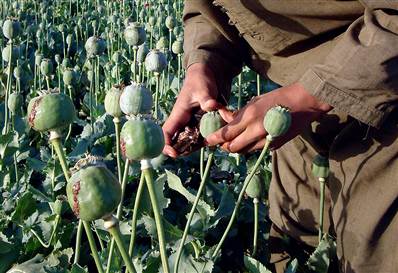 In several Afghan provinces the fight to curb the growing of opium poppies seems to be a losing battle.
In several Afghan provinces the fight to curb the growing of opium poppies seems to be a losing battle.
In 2011 a United Nations Office on Drugs and Crime survey said opium poppy cultivation rose by 7% overall from the prior year. Opium poppy has been one of the main sources of funding for the Taliban especially since the U.S. invasion of Afghanistan in 2001. Poppy cultivation is expected to grow partly because the opium poppy’s prices are rising and because farmers are having a hard time deriving as much profit from alternative crops.
But one Afghan province is showing real progress in doing just that. The alternative crop is the world’s most expensive spice, saffron.
Farmers in Herat, Western Afghanistan, say not only does saffron fetch more profit than poppy but they have also found an enticing way to market it. It is packaged in beautiful little tins or what look like perfume bottles. The farmers are hoping the government will do even more to help Afghan saffron become a known commodity worldwide.
Herat is an ancient city marked by a towering mosque, a distinct Iranian influence, bustling markets and an improving economy. What is happening in Herat province, the government says, is a good argument for a spice revolution: replacing opium poppy crops.
“Herat province has been cleaned of 99% of its poppy cultivation,” Basheer Ahmad Ahmadi, the Head of Agricultural affairs in the Herat province’s agricultural department, told CNN. “The 1% is in places with some security problems. The government, cooperation of NGOs, some donations and USAID has played an important role to help and encourage saffron cultivation.”
But for farmers like Hajji Ibrahim Aadil, it’s not just as simple as deciding to switch. After changing his crop from poppy to saffron he says he had unwanted visitors.
“Taliban took money from me,” Aadil told CNN. “I walked for days with my eyes wrapped with a piece of cloth. I was kept in a well for two days. Finally, they told me to stop promoting the cultivation of saffron.”
Instead, he and his 13 family members moved, and now freely grow and sell saffron, which he says brings in more profit than poppy ever did. Enough to buy a large home in a safe and relatively peaceful environment, where his young daughters are going to school.
“I always wanted my girls to be educated,” Aadil said.
The Afghan government, along with NATO members, has been trying to stem the growth of the opium poppy. Still, 90 % of the world’s opium is produced in Afghanistan and it brought in an estimated $1.4 billion last year. Much of that ended up with Taliban and government-linked warlords.
Saffron, which is used in food and can be used as a dye, is being looked at as a potential gold mine in Herat. It is a far easier crop to plant and harvest than opium poppy, and it aligns with the tenets of Islam and gives new opportunities for Afghan women.
Pari Gul Danish Yaar sits at a table with a large pile of saffron in front of her. She is carefully eyeing each strand as she takes her tweezers and picks out the unwanted pieces.
“Even a small mistake shouldn’t be made,” she said. “I take the useless things out in the best possible way. It is used for important purposes like eating and it is necessary to wash your hands with soap before handling it.”
She is happy doing this delicate work because she says she wouldn’t have a job if it weren’t for saffron cultivation. Working with poppy was forbidden in her household.
“Neither my family would allow me and nor would I participate in it,” she said. “I am very happy with this work because it is very useful for Afghanistan and other countries. This is a legal work.”
Dozens of companies have been formed, with the aim of exporting Afghan saffron abroad. In one store with mirrored walls the packaging gives you a sense that whatever is inside must be something special. The glittering shop has what looks like perfume bottles in different shapes and sizes and small decorated tins. Inside are strands of saffron. Cooks know you only need a few strands of the expensive spice to make a meal mouth watering.
But Saffron’s success here isn’t without pitfalls.
“There were times that we couldn’t export our saffron to other countries,” Aadil said. “The government of Afghanistan should help out with this. We don’t have any department that can standardize and market our saffron so that our saffron could be sold to other countries, like Iran, Spain and other foreign countries.”
And since the government and some NGOs are handing out so many saffron bulbs to encourage farmers such as Aadil, there is the potential for flooding the market and bringing the price of this precious spice down. In a country still suffering from decades of war, there is also the issue of quality control, and farmers say they need more and better processing and packaging plants.
It is something Ahmadi says is being worked out. “We are having processing and packing problems but I assure you that we will overcome these problems in the next two years,” he said. “The main problem that we have is issuing certificate. Now we have three saffron laboratories in Herat agricultural department where we can do three kinds of tests: color, smell and taste.”
Afghans like farmer Aadil hope the obstacles farmers face will disappear as they eye the world markets where the deep red spice can fetch thousands of dollars per pound.